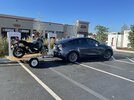It sure is.I have also read many people saying they just use a ball hitch and are fine but that seems to be more risk to me.
And they are “fine” until they have to perform an emergency maneuver while towing and then lose control of their vehicle as it is whipsawed by the mass of their trailer.



